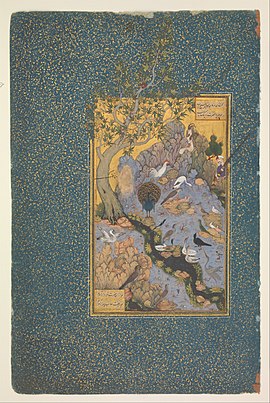The Conference of the Birds

The Conference of the Birds or Speech of the Birds (Template:Lang-fa, Manṭiq-uṭ-Ṭayr, also known as مقامات الطیور Maqāmāt-uṭ-Ṭuyūr; 1177), is a long and celebrated Sufi poem of approximately 4500 lines written in Persian by the poet Farid ud-Din Attar, who is commonly known as Attar of Nishapur.
In the poem, the birds of the world gather to decide who is to be their king, as they have none. The hoopoe, the wisest of them all, suggests that they should find the legendary Simorgh, a mythical Persian bird roughly equivalent to the western phoenix. The hoopoe leads the birds, each of whom represent a human fault which prevents man from attaining enlightenment. When the group of thirty birds finally reach the dwelling place of the Simorgh, all they find is a lake [citation needed] in which they see their own reflection.
Besides being one of the most celebrated examples of Persian poetry, this book relies on a clever word play between the words Simorgh – a mysterious bird in Iranian mythology which is a symbol often found in sufi literature, and similar to the phoenix bird – and "si morgh" – meaning "thirty birds" in Persian.
- It was in China, late one moonless night,
- The Simorgh first appeared to mortal sight –
- He let a feather float down through the air,
- And rumours of its fame spread everywhere;[1]
The story recounts the longing of a group of birds who desire to know the great Simorgh, and who, under the guidance of a leader bird, start their journey toward the land of Simorgh. One by one, they drop out of the journey, each offering an excuse and unable to endure the journey. Each bird has a special significance, and a corresponding didactic fault. The guiding bird is the hoopoe, while the nightingale symbolizes the lover. The parrot is seeking the fountain of immortality, not God, and the peacock symbolizes the "fallen soul" who is in alliance with Satan.
The birds must cross seven valleys in order to find the Simorgh: Talab (Yearning), Ishq (Love), Ma'rifat (Gnosis), Istighnah (Detachment), Tawheed (Unity of God), Hayrat (Bewilderment) and, finally, Fuqur and Fana (Selflessness and Oblivion in God). These represent the stations that a Sufi or any individual must pass through to realize the true nature of God.
Within the larger context of the story of the journey of the birds, Attar masterfully tells the reader many didactic short, sweet stories in captivating poetic style. Eventually only thirty birds remain as they finally arrive in the land of Simorgh – all they see there are each other and the reflection of the thirty birds in a lake [citation needed] – not the mythical Simorgh. As the birds realize the truth, they now reach the station of Baqa (Subsistence) which sits atop the Mountain Qaf.
Attar's masterful use of symbolism is a key, driving component of the poem. This adroit handling of symbolisms and allusions can be seen reflected in these lines:
- It was in China, late one moonless night,
- The Simorgh first appeared to mortal sight –
Beside the symbolic use of the Simorgh, the allusion to China is also very significant. According to Idries Shah, China as used here, is not the geographical China, but the symbol of mystic experience, as inferred from the Hadith (declared weak by Ibn Adee, but still used symbolically by some Sufis): "Seek knowledge; even as far as China".[2] There are many more examples of such subtle symbols and allusions throughout the Mantiq.
La Conférence des oiseaux
Peter Brook and Jean-Claude Carrière adapted the poem into a play titled La Conférence des oiseaux (The Conference of the Birds), which they published in 1979. Brook toured the play around rural Africa before presenting two extremely successful productions to Western audiences—one in New York City at La MaMa, E.T.C. and one in Paris.[3]
An English translation of the show was performed in 2014 at the B Street Theatre in Sacramento, California.
See also
- Language of the birds
- Panentheism
- Parlement of Foules
- Persian literature
- Sheema Kalbasi (editor and translator of Seven Valleys of Love, a bilingual anthology of poetesses from Persian Middle Ages to present day)
- The Approach to Al-Mu'tasim
- The Seven Valleys (Bahá'í)
References
- ^ quoted from The Conference of the Birds by Farid al-Din Attar, edited and translated by Afkham Darbandi and Dick Davis, Penguin Classics, 1984, ISBN 978-0-14-044434-6
- ^ Idries Shah, The Sufis, with an Introduction by Robert Graves
- ^ John Heilpern gives an account of the events surrounding these performances in his 1977 book Conference of the Birds: The Story of Peter Brook in Africa.
- Attar, Harvey & Masani, Conference of the Birds: A Seeker's Journey to God, Weiser Books, 2001, ISBN 1-57863-246-3
- Farid Ud-Din-Attar, The Conference of The Birds - Mantiq Ut-Tair, English Translation by Charles Stanley Nott, First published 1954 by The Janus Press, London, Reissued by Routledge and Kegan Paul Ltd, 1961, ISBN 0-7100-1032-X
- Fariduddin Attar in Great POets of Classical Persian" by R M Chopra, 2014, Sparrow Publication, Kolkata, ISBN 978-81-89140-75-5.
External links
- Bird Parliament Fitzgerald translation, at archive.org.
- Selection of Attar and related poets' poetry
- Simurgh: A modern musical rendering of Attar's allegorical tale
- The Conference of the Birds, available from the Packard Humanities Institute
- Abridged Edward FitzGerald translation of Attar's Conference of the Birds
- Conference of the Birds, an opera by Johan Othman and libretto by William Radice
